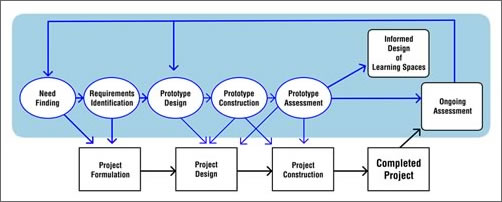Learning Spaces

Space, whether physical or virtual, can have a significant impact on learning. Learning Spaces focuses on how learner expectations influence such spaces, the principles and activities that facilitate learning, and the role of technology from the perspective of those who create learning environments: faculty, learning technologists, librarians, and administrators. Information technology has brought unique capabilities to learning spaces, whether stimulating greater interaction through the use of collaborative tools, videoconferencing with international experts, or opening virtual worlds for exploration. This e-book represents an ongoing exploration as we bring together space, technology, and pedagogy to ensure learner success.
Marker Boards, Wireless Access, and Technology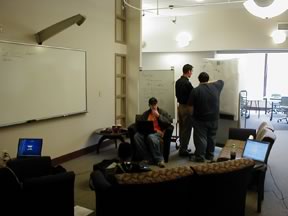
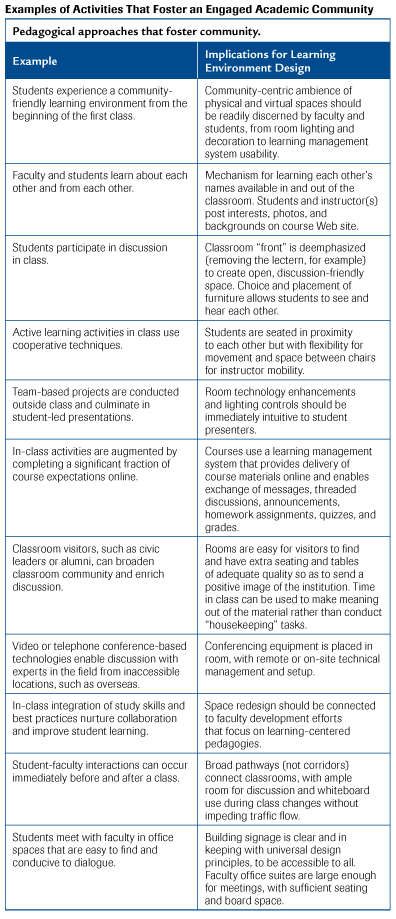
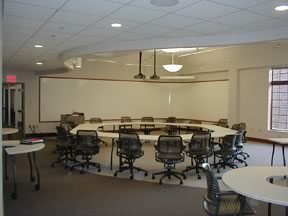
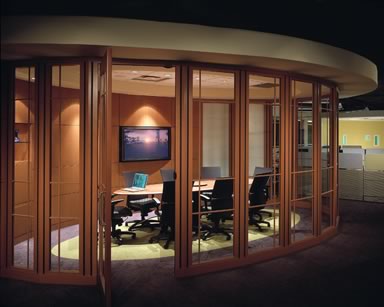
Initiate Active Prototyping Programs
Existing design practice has an unfortunate byproduct: learning space technologies typically are purchased and deployed in a single linear process. Building committees often make decisions about what technologies to deploy throughout a new building without having an opportunity to try them on a more limited scale. A better approach would establish an ongoing program of structured prototyping and evaluation that iteratively tests new ideas and technologies in a series of experimental and then operational settings. Prototypes provide tacit knowledge not available in a theoretical design. In the near term, prototyping might take the form of critical function prototypes, in which a particular capability or subsystem is deployed and tested early in the design process or while the building is under construction. Feedback from this trial would then influence the system design work later in the project life cycle.
In the long term, more substantial changes are needed. Sustainable prototyping programs funded through augmentation of operating budgets will permit explorations not limited to specific building projects. This will enable the creation of permanently unfinished spaces that would become test beds for new technologies and approaches. Institutions can begin by designating a small portion of the building technology budget for prototyping while the structure is being erected. Over time, this kind of activity could be leveraged across collaborating institutions, so that costs and best practice results could be shared. Successful design approaches will integrate ongoing needs analysis and prototyping activities. (See Figure 2.)
Practice Truly Participatory Design
The lack of long-term, meaningful student involvement in building design projects is common. Although a student or two may be invited to join a committee to represent the interests of the entire student population, this seriously underrepresents a group that constitutes the majority of those who use learning spaces on a daily basis. Because of the lack of student representation, groups typically responsible for learning space design risk making decisions with a limited perspective on the total life of learning spaces.
To promote a more participatory design process, students, faculty, staff, and design professionals should be engaged in the kinds of needs-finding and prototyping efforts described earlier. Design teams could also facilitate design workshops, or charrettes, that provide a focused opportunity to explore ideas and develop a sense of design priorities, both in terms of specific design requirements and the more ephemeral aspects of the design intent.
In the future, design teams will evolve to include individuals with expertise in blended environments that address human interaction issues in terms of physical design and technology interfaces. These teams will not only design physical environments, they will be involved in designing the interaction technologies embedded within these spaces.
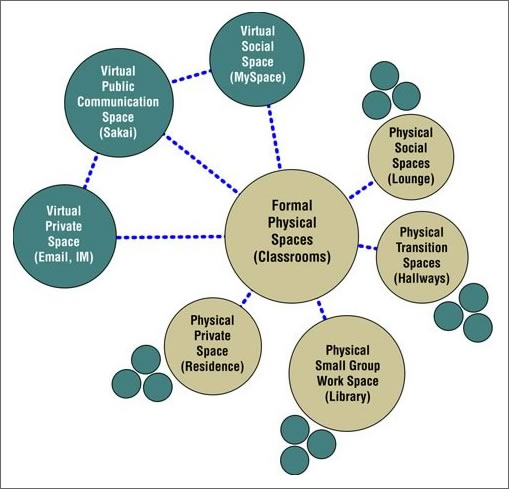
Designing for Experimentation and Innovation
Institutions are designing places for experimentation and innovation. Depending on the learning activity, a different combination of pedagogy, space, and technology might be optimal. Learning innovations that have improved student success, such as SCALE-UP (see chapter 29) and the Math Emporium at Virginia Tech (see chapter 42), resulted from experimentation. Others, such as Stanford's Wallenberg Hall (see chapter 36) and the Ohio State University's Digital Union (see chapter 31) set aside space for prototyping and experimentation. The presence of movable furniture, screens, and wireless controls makes it possible to experiment with just about any space.
Locating different disciplines (for example, fine arts and technology) in the same space can catalyze innovation and experimentation, as in the case of Denison University's MIX Lab (see chapter 16). In other cases, such as BOX at the London School of Economics (see chapter 23), the innovation comes from colocating academic and business personnel. Joint projects and problem solving encourage innovative thinking.
It is increasingly common—and necessary—for institutions to integrate experimentation into the overall design process. Years may pass between the time space planning begins and a facility's completion. In that time pedagogy and technology will change. And, with the lifespan of a facility exceeding 50 years and the half-life of many technologies being one to two years, flexibility and renewal must be an ongoing part of the design process.
Emerging patterns include:
- Setting aside space for experimentation
- Colocating different specialties in the same facility to stimulate innovation
- Displaying art work, exhibits, and artifacts to stimulate interest and creativity
- Using a portion of the budget for technology experimentation
Involving Users
Increasingly users—students, faculty, and staff—participate in learning space design. User perspectives are critical, as architects or facilities personnel may view space design quite differently. "In fact, 'expert' decisions are not necessarily better than 'lay' decisions," asserted Henry Sanoff. "Given the facts with which to make decisions, users can examine the available alternatives and choose among them."17 Completing the facility is not the end of the process, however; it must be adapted to changing needs. Sanoff concluded that "Those most directly involved with the product—the users—are best able to assume those tasks."
Users' involvement in ongoing maintenance and management might also be valuable. This involvement could be directly on committees or indirectly through surveys or interviews, such as at the Manuel Pacheco Integrated Learning Center at the University of Arizona (see chapter 37).
Emerging patterns include:
- Getting input from students on different types of spaces, such as through photo surveys, rather than through committee appointments
- Involving users in creating new designs
- Forming user councils that involve facilities, IT, academic affairs, faculty, and students
Innovative Vision Yields Innovative Outcomes
At a meeting in 2003, instructional technologists and the chairpersons of Denison's fine and performing arts departments (Studio Art and Art History, Cinema, Dance, Music, and Theatre) focused on digitizing the disciplines. Convinced of the importance of "creative computing" (the analog to research computing for the arts), the chairs and staff developed a proposal1 with an innovative vision to "blur distinctions among disciplines and build bridges among our departments for both students and faculty." The goal was to create new synergies among the five fine arts departments.
The faculty's innovative vision was for curricular synergy—a focus on a single, technologically-rich space to foster collaboration, learning, and interdisciplinary work for both students and faculty. Our institutional leaders committed space and funds to make the vision a reality. The instructional technologists carefully integrated a large array of hardware and software tools to meet the faculty's interdisciplinary goals.....
Faculty-directed student teams work together on joint projects and generate new work processes and relationships among the traditionally separated disciplines. Faculty also benefit from each other's experiences, talents, and skills. Throughout the day, faculty members from all five disciplines hold classes in the lab and give students hands-on opportunities to experiment with the new tools and equipment. When the lab is not being used for instruction, students, faculty, and staff from across the university can use the space for their own projects. The open design of the space invites individuals to work together comfortably on joint projects.
Transformed Space That Transforms the Curriculum
Marginal improvements to a space rarely change the teaching and learning practices that take place there. Transformational changes may change practices, but such broad, sweeping changes require a strong, shared vision and an institutional commitment to potentially high-risk projects. We often lower risks by working incrementally toward a shared vision, but incremental improvements (such as better seating or room color) neither alter our teaching practices and learning outcomes nor expand our thinking about what might be possible. Converting a nonacademic space into a learning space provides a unique opportunity to discover authentic learning outcomes that arise from learning space transformations.
The MIX Lab, a transformed space, has in turn transformed the fine arts curriculum. Interest in creative computing runs high, and faculty members have adopted collaboration as a best practice. New courses integrate the visual arts with music in new ways, while dance and theater performances showcase the products and processes derived from the MIX Lab. Ever more ambitious student projects require collaboration for success. Based on the MIX Lab model, the fine arts are planning a "Center for Collaboration in the Arts."
...
The MIX Lab is both the cause and effect of innovation, a transformed space that has transformed the curriculum. More than any other learning space at Denison, it has changed the way students and artists work and learn. The interdepartmental vision of a shared space has produced a successful technological learning space that has spawned greater aspirations for collaboration. The MIX Lab provides a unique example of how technology can break down barriers, promote new approaches to teaching and learning, and foster broad curricular transformation.
Chapter 28. FlyspaceWhat Is It?
Figure 2. Simple Design with Whiteboards Everywhere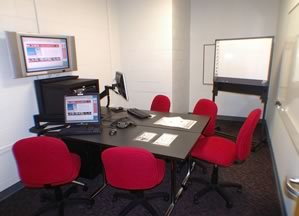
Flyspace is a simple design for a meeting space for five to six students. It is intended to be inexpensive, modular, and compact. Keeping room sizes small fosters an intimate area for collaboration and makes it more likely that other rooms can be built around a campus with chronic space shortages.
Dot-com startups inspired Flyspace. These companies grew so quickly that they couldn't house all their employees, sometimes replacing offices with laptops and an open room with lots of flat work spaces. Offices with doors were converted into scheduled spaces for client meetings, brainstorming, or simply a quiet space to work. This nontraditional use of space fostered creativity and collaboration among employees.
Flyspace offers just enough technology to foster collaboration; technology is not the main feature of these rooms. The emphasis is on flat work areas, including extensive use of whiteboards along all walls.
The basic technology infrastructure is inexpensive to build and expand. Flyspace uses a basic design consisting of two computers with displays mounted on articulated arms and connectivity (data, video, and audio) for four laptops. A large flat-panel display allows users to share their desktops with others. A centralized pod contains all data and power connectors for equipment in the room, making it easy to connect equipment and minimizing the cost of running conduit for data, media, and power. Wireless networking is also available. Students can make on-campus calls or report problems by phone, and the speakerphone makes it possible for off-campus students and faculty to participate in Flyspace meetings. Perhaps the most important feature of Flyspace is an open scheduling system that lets any registered student schedule a space for a meeting or group project. (See Figure 1.)
How Is Technology Used?
Flyspace facilitates collaboration, brainstorming, and various pursuits unlimited by rules on the rooms' use. An open, Web-based scheduling system lets users see if the space is available immediately, without having to authenticate, and they can schedule space without having to ask permission. Because every user in the room has access to the room-control system from his or her computer, seamless switching between participants is possible. No one person controls who has access to the screen; it is truly a collaborative experience. Moreover, the large amount of whiteboard space and markers allow students to brainstorm-with or without technology.
....A central piece of Flyspace is not the room itself but an open scheduling system.... Flyspace rooms show up as a campus resource that can be scheduled by anyone, whether student, staff, or faculty. Instead of using expensive videoconferencing hardware, Flyspace uses Web-based conferencing tools, which require less technology and align better with the ways students collaborate. An echo-canceling microphone connected to one computer allows everyone in the room to be heard; no expensive, dedicated videoconferencing equipment is needed.
What Makes the Space Successful?
A number of features contribute to the area's success.
No boundaries: No barriers separate the InfoCommons from the main library corridor, yet the space successfully creates small enclaves of privacy in a completely open area. The InfoCommons provides spaces that allow students to work together-to solve problems, exchange ideas, and work collaboratively. The casual passerby can view activity and easily become part of it. Particularly in the booths (see Figure 4) and at the presentation stations, students remain unaware-or perhaps uncaring-of passersby, opening their lives and work to all who might see.
Figure 4. Enclaves of Privacy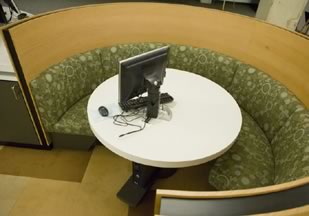
Challenging and changing cultures: The concept of a learning space such as the InfoCommons can challenge those with traditional views of "learning" and "space." Library staff accustomed to following long-established routes to their offices and departments through the busy InfoCommons, for example, now view it differently. The high visibility of the area's social and learning capability is often a new idea, especially for visitors and prospective students (who embrace it with enthusiasm).
A social space: The InfoCommons is a first stop for many students entering the library. (See Figure 5.) It offers a welcoming social environment where they engage in independent inquiry, participate in small group interactions, or sip coffee from the nearby café.
Figure 5. A First Stop for Many Students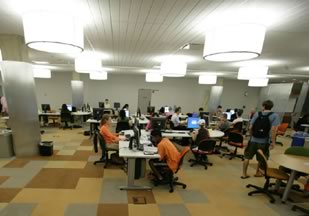
Informality: The project room was initially envisioned as a glassed-off formal conference room, complete with a large table surrounded by chairs, distinguishing it from the rest of the InfoCommons. By contrast, the room's actual success can be attributed to the shift away from this planned formality to a relaxed setting rich in technology that blends unobtrusively, versatile and comfortable chairs, and a surprisingly low "coffee table" with a wireless keyboard, data, and power ports-at the right height for feet. (See Figure 6.)
